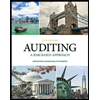
AUDITING RMU
11th Edition
ISBN: 9781260934830
Author: MESSIER
Publisher: MCGRAW-HILL HIGHER EDUCATION
expand_more
expand_more
format_list_bulleted
Question
Chapter 16, Problem 16.29P
To determine
Concept Introduction:
Audit procedure is a method performed by the auditor, to gather the possible document that helps the auditors to make a strong conclusion. The audit procedure helps to determine the nature of the financial information provided by the customers and all kinds of risks that occur in the financial statements. Audit procedure performs different test of controls to avoid the risks.
To discuss: The appropriate audit procedure for the selected assertions.
Correct match of selected assertion with the audit procedure is mentioned below:
| Specific Assertion | Audit Procedure | |
| a) | Verify that investment are properly described and classified in the financial statement (Presentation and disclosure-classification) | The auditor needs to develop an audit procedure to check that is transferred from the current to the noncurrent investment portfolio, that have been properly recorded. |
| b) | Verify that recorded investments represent investment actually owned at the | In this assertion, the auditor needs to obtain positive confirmations of the balance sheet date of investment held by independent custodians. |
| c) | Verify that investment are properly valued at the lower of cost or market at the balance sheet date (valuation and allocation) | Out of the |
Expert Solution & Answer
Want to see the full answer?
Check out a sample textbook solution
Students have asked these similar questions
What does the internal rate of return (IRR) tell you about a potential investment?
Explain the difference between systematic risk and unsystematic risk. Which one can be diversified away?
What is the formula for calculating the present value of a future cash flow, and why is discounting used in finance?
Chapter 16 Solutions
AUDITING RMU
Ch. 16 - Prob. 16.1RQCh. 16 - Prob. 16.2RQCh. 16 - Prob. 16.3RQCh. 16 - Prob. 16.4RQCh. 16 - Prob. 16.5RQCh. 16 - Prob. 16.6RQCh. 16 - Prob. 16.7RQCh. 16 - Prob. 16.8RQCh. 16 - Prob. 16.9RQCh. 16 - Prob. 16.10RQ
Ch. 16 - Prob. 16.11RQCh. 16 - Prob. 16.12MCQCh. 16 - Prob. 16.13MCQCh. 16 - Prob. 16.14MCQCh. 16 - Prob. 16.15MCQCh. 16 - Prob. 16.16MCQCh. 16 - Prob. 16.17MCQCh. 16 - Prob. 16.18MCQCh. 16 - Prob. 16.19MCQCh. 16 - Prob. 16.20MCQCh. 16 - Prob. 16.21MCQCh. 16 - Prob. 16.22MCQCh. 16 - Prob. 16.23MCQCh. 16 - Prob. 16.24PCh. 16 - Prob. 16.25PCh. 16 - Prob. 16.26PCh. 16 - Prob. 16.27PCh. 16 - Prob. 16.28PCh. 16 - Prob. 16.29PCh. 16 - Prob. 16.30P
Knowledge Booster
Similar questions
- What is the formula for calculating the present value of a future cash flow, and why is discounting used in finance? Explaarrow_forwardExplain the difference between systematic risk and unsystematic risk. How can an investor reduce unsystematic risk in their portfolio?need help!arrow_forwardExplain the difference between systematic risk and unsystematic risk. How can an investor reduce unsystematic risk in their portfolio?arrow_forward
- A firm has a project with an initial investment of $100,000 and cash inflows of $30,000 per year for 5 years. If the firm’s required rate of return is 10%, should the project be accepted based on its net present value (NPV)? Need helparrow_forwardA firm has a project with an initial investment of $100,000 and cash inflows of $30,000 per year for 5 years. If the firm’s required rate of return is 10%, should the project be accepted based on its net present value (NPV)?arrow_forwardDefine capital structure. What are the main factors that influence a company's decision on how much debt versus equity to use? Exparrow_forward
- Define capital structure. What are the main factors that influence a company's decision on how much debt versus equity to use?arrow_forwardAns A company has a beta of 1.2, the risk-free rate is 3%, and the expected market return is 8%. Using the Capital Asset Pricing Model (CAPM), calculate the expected return on the company's stock. Need help !!!arrow_forwardA company has a beta of 1.2, the risk-free rate is 3%, and the expected market return is 8%. Using the Capital Asset Pricing Model (CAPM), calculate the expected return on the company's stock.arrow_forward
- A firm issues a preferred stock with a dividend of $6 per year. If the market price of the preferred stock is $80, what is the cost of preferred equity for the firm?arrow_forwardGive answer.Explain the difference between a primary market and a secondary market. Why are both important in financial markets?arrow_forwardExplain the difference between a primary market and a secondary market. Why are both important in financial markets? Need help!!arrow_forward
arrow_back_ios
SEE MORE QUESTIONS
arrow_forward_ios
Recommended textbooks for you
 Auditing: A Risk Based-Approach (MindTap Course L...AccountingISBN:9781337619455Author:Karla M Johnstone, Audrey A. Gramling, Larry E. RittenbergPublisher:Cengage Learning
Auditing: A Risk Based-Approach (MindTap Course L...AccountingISBN:9781337619455Author:Karla M Johnstone, Audrey A. Gramling, Larry E. RittenbergPublisher:Cengage Learning

Auditing: A Risk Based-Approach (MindTap Course L...
Accounting
ISBN:9781337619455
Author:Karla M Johnstone, Audrey A. Gramling, Larry E. Rittenberg
Publisher:Cengage Learning